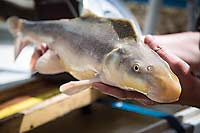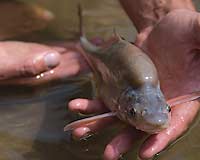What is sound?
Similar to light, sound is a vibration, a wave form. Sound is transformed into electro-chemical impulses in the cochlea of the ear and sent to the brain where it is further processed. Sound connects us to our environment, alerts us to danger, allows us to understand language, speak and be heard.
 Sound is vibration (rhythmic back / forth motion) and frequency (speed at which something vibrates). With the help of thousands of special hair cells in the spiral shaped organ named the cochlea, we can perceive a range from 20-20,000 vibrational cycles per second. The cochlea responds to sound pressure waves (pitch, intensity, timbre, duration of tones), allowing us to appreciate music, as well as the emotional content of language. Sound is vibration (rhythmic back / forth motion) and frequency (speed at which something vibrates). With the help of thousands of special hair cells in the spiral shaped organ named the cochlea, we can perceive a range from 20-20,000 vibrational cycles per second. The cochlea responds to sound pressure waves (pitch, intensity, timbre, duration of tones), allowing us to appreciate music, as well as the emotional content of language.
Sound provides a non-tangible, yet highly personal connection between people and nature. Our primary form of communication is through the production of language, songs, tones, and noises. The diminishment or loss of this contact often makes social maturation and emotional relationships quite difficult. As a predominant element of human interaction and exchange, sound is of tremendous value. Our hearing is more precious than we tend to realize.
The vestibulo-cochlear system (aka inner ear) is responsible for many functions in addition to hearing. This system receives information from the environment relative to gravity and motion and is responsible for coordination, balance, muscle tone, and precise motor execution. The proper functioning and organization of the vestibular system is essential to all higher learning, the coordination of eye-hand movement, rhythm, and a sense of where the body is located in space.
Sound literally touches us from top to bottom – The Vagus Nerve
There are many cranial nerves associated with the inner ear; however, the most fascinating to me is the 10th cranial nerve named the vagus (wandering or vagabond) nerve, because it meanders throughout our thoracic and abdominal cavities. The vagus nerve regulates the larynx, heart, lungs, stomach, liver, bladder, kidneys, small intestines, and colon. It attaches onto the outer and inner eardrum on its way from the brain heading south. This means that mixed into the parasympathetic instructions to our major organs are the vibrations from the eardrum.
Noise pollution – It’s Everywhere - “The Muffled Epidemic”
Is sound/noise stealing our hearing? More particularly how are the decibel levels (dBA, measuring sound and noise) produced from various sources affecting us? An example might include an aerobics class where the music is amplified to hit 105 dBA (like standing on a fire engine with the siren going) in order to produce an adrenaline rush that would keep us exercising. According to the National Institute of Occupational Safety and Health, even continued exposure to 85-decible levels threatens hearing loss. Below is a list that will help illustrate the range of environmental noise levels that affect everyone in society.
0- the quietest sound audible via normal hearing
10- normal breathing
20- whispering from 5 feet away
30- soft whispering
40- quiet office
50- rain fall/refrigerator
60- regular conversation
70- highway traffic
85- noisy restaurant / heavy traffic
100- commercial semi-trucks /
shouting directly into the ear
120- thunder
Perhaps you’ve experienced the sound pollution caused by the all-terrain vehicles that visit Moab. Some states (Wisconsin, California, Oregon, Minnesota, Michigan, Illinois, Iowa) have regulations that prohibit ATV’s from emitting noise that is louder than 96 dBA, still louder than 85.
The physiological effects of sound
Noise pollution has been found to cause hypertension, elevated blood pressure, cardiovascular problems, chronic fatigue, tinnitus, hearing loss, sleep disturbance, compromised immune functioning, and overall decreased quality of life.
In my opinion, our community needs to consider what we can do to preserve the quietness of the desert that brought many of us here in the first place. Do you agree that it is hard to find the silence?
Article written by Annette Kearl, PhD, Music/Sound Therapist in May of 2017 completed her doctorate on the effects of vibrational sound on mind-body physiology and well-being.
|
The razorback sucker (Xyrauchen texanus) and humpback chub (Gila cypha) are two of four native endangered fish species in the Colorado River basin. Various state and government agencies working in the basin have spent years conducting hatchery rearing and stocking efforts, comprehensive studies on fish populations, and management of non-native predators. In the past year, the U.S. Fish & Wildlife Service (USFWS) has proposed that the humpback chub and razorback sucker should be downlisted from endangered to threatened.
 |
| An adult razorback sucker (Xyrauchen texanus). PC John Caldwell. |
These fish are endemic to the Colorado River basin, which means that this is the only place in the world where these species have been found. The razorback sucker and humpback chub are aptly named for their respective sharp keel and pronounced fleshy hump just behind their heads. Razorback suckers can live for more than 40 years and grow up to 3 feet in length and is one of the largest suckers in North America. Humpback chubs typically live for about 30 years and grow up to about 20 inches in length. It is estimated that both species evolved about 3 to 5 million years ago, predating humans. It is clear why such an intense effort has been put forth to recover these rare, ancient fish species.
After a species status assessment and a 5-year status review of both fish, the USFWS believe that the fish may no longer be at imminent risk of extinction throughout their range. This suggests that the fish no longer need the endangered classification.
Razorback suckers in the Green River came from near the brink of extinction in the mid-1990s to now when the population is over 30,000 adults. This is due to successful hatchery stocking. It is clear, however, that although stocked razorbacks are reproducing, the wild young-of-year fish struggle to survive to adulthood. This is largely due to predation by non-native species, lack of nursery habitat, and an altered flow regime.
 |
| An adult humpback chub (Gila cypha). PC John Caldwell |
The largest stable population of humpback chub is 12,000 individuals in the Lower Colorado River and Little Colorado River of the Grand Canyon. Other smaller, but seemingly stable populations exist on the Upper Colorado River in Black Rocks, Westwater Canyon, Cataract Canyon and on the Green River in Desolation and Gray Canyon. Monitoring of these populations has shown that humpbacks continue to thrive and do not currently need hatchery stocking. Humpbacks, however, still need support through flow management and non-native predator control.
It is expected that a final decision will be made about whether the humpback chub and razorback sucker will be officially downlisted or not by October 2020 and October 2021, respectively. If determined appropriate, the reclassification of the fish will include a revised recovery plan for each species. These recovery plans will use the most current scientific information on species needs to increase and support fish survival.
It is no surprise that the rivers which make up such a magnificent landscape are home to such extraordinary creatures. We hope that they can continue to swim about these muddy waters.
|
 Sound is vibration (rhythmic back / forth motion) and frequency (speed at which something vibrates). With the help of thousands of special hair cells in the spiral shaped organ named the cochlea, we can perceive a range from 20-20,000 vibrational cycles per second. The cochlea responds to sound pressure waves (pitch, intensity, timbre, duration of tones), allowing us to appreciate music, as well as the emotional content of language.
Sound is vibration (rhythmic back / forth motion) and frequency (speed at which something vibrates). With the help of thousands of special hair cells in the spiral shaped organ named the cochlea, we can perceive a range from 20-20,000 vibrational cycles per second. The cochlea responds to sound pressure waves (pitch, intensity, timbre, duration of tones), allowing us to appreciate music, as well as the emotional content of language. 
